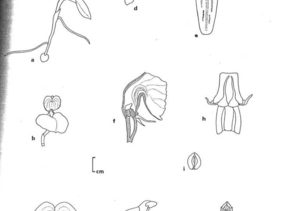You are here
Acianthinae_species
Corybas despectans D.L. Jones & R.C. Nash
Nomenclature
-
Subgenus: CorysanthesSection: Corysanthes
-
Synonyms: 1
Media
SUMMARY
Leaves: 8-25 x 12-30 mm, cordate to orbicular, occasionally lobed, apiculate, green on both surfaces.
Ovary: 3-5 mm long, narrow, subtended by a small narrow bract.
Flower: 7-12 mm long, reddish-purple, dominated by the lamina of the labellum, sessile or almost so.
Dorsal sepal: 6-11 x 3-4 mm when flattened out, greenish-grey with some purple striations, spathulate-oblong, concave, carinate, erect in the lower half then curving gently through about 60 deg, the apex acute or obtuse, often irregularly notched.
Lateral sepals: about 5x0-8 mm narrow acute, connate at base, tapered from base to extremity, apex entire.
Lateral petals: about 2-0 x 0-8 mm, slightly falcate, winged at the base where they join the column, then tapering to filiform points, often notched.
Labellum: longer than dorsal sepal; labellum-tube 4-5 mm long about equal in length to the lamina, erect for about 4 mm then abruptly decurved through 180° and greatly expanded into an almost circular lamina; lamina 7-8 x 9-11 mm reddish with conspicuous venation, its margins slightly denticulate
Boss: flat almost triangular inconspicuous; callus consisting of about four raised divergent plates, occasionally adorned with minute teeth.
Auricles: extremely small directed downward with a minute opening hidden by the base of the lateral petals.
Column: about 2-5 mm long, narrow, of nearly equal width throughout, minutely winged. Stigma ±1.5 mm in diam., ± rectangular concave. Anther 1-1-5 mm long, entire. Pollinarium 1-0 x 0-8 mm, consisting of 4 pollinia in two pairs, attached directly to a reniform viscidium 0-5 mm long. Pollinia mealy.
Distribution: At present known from south-eastern and southern South Australia in low Mallee or open eucalypt forest under bracken. An extension into Victoria is to be anticipated as it occurs very close to the border.
Ecology: It has been found growing close to the sea or inland with the habitat varying from light sandy soil in low Mallee to eucalypt forest (often over limestone). In common with most Corybas species it grows in large colonies.


